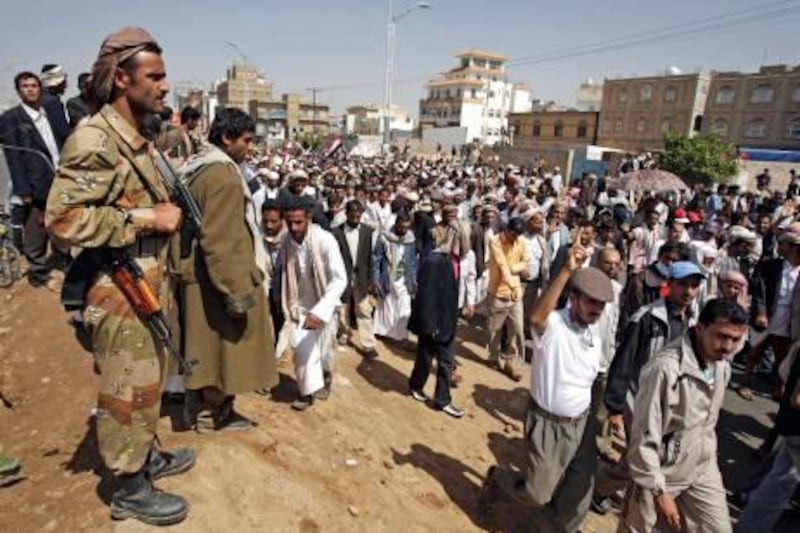SANAA // Sanaa has never had a reputation as a city opposed to a citizen's right to own firearms or even to use violence to settle disputes. After all, learning how to fire an assault rifle has been a rite of passage for young men and, in some cases, a necessity to fend off intruders, hostile clansmen or members of rival political parties.
But what the Yemeni capital and its estimated 3.5 million residents never counted on is for their ancient city to be a battlefield for rival armies fighting with rockets, mortars, rocket-propelled grenades and anti-aircraft guns.
Furthermore, the city - nestling amid rocky hills to the north and south - now appears divided, with each of the rival factions claiming control of parts of it, complete with their own checkpoints and sandbagged gun positions. Light tanks, fighting vehicles and armoured personnel carriers fitted with a heavy machineguns are now a common sight in the capital.
Regime snipers are stationed on rooftops in parts of the city and, at times, they fire randomly on unwitting passers-by, possibly to feed tension and strike fear among the protesters.
Hardly a night goes by now in Sanaa without the sky lighting up with the flash of gunfire or explosions. Often, the city rocks to the sound of explosions, sending residents hurrying to the relative safety of basements. Adding to the atmosphere of a city at war are the lengthy power outages that sometimes last 24 hours in some areas.
Sanaa appears to be on the brink of civil war, a prospect that could herald the break-up of the deeply tribal nation that is also home to the world's most active branch of Al Qaeda. By clinging to power, President Ali Abdullah Saleh is making that prospect more real.
Ironically, the genesis of Sanaa's predicament is the anti-regime protest movement that wants to overthrow the rulers through peaceful means.
Inspired by Arab Spring revolts in Egypt and Tunisia, the Yemeni protesters took great pains not to resort to violence in the face of the live ammunition and tear gas used against them.
For several weeks, scores of protesters were killed and wounded, but the movement's commitment to peaceful protest did not waver and the regime appeared to be increasingly fragile. Hundreds of thousands took to the streets across this poor Arab nation chanting "erhal" - Arabic for "leave."
For sometime around early March, Mr Saleh's regime appeared about to fall.
But something else happened. The chiefs of major tribes that had been longtime supporters of Mr Saleh decided to leave him and join the opposition. Then came the defection of Major General Ali Mohsen Al Ahmar, commander of the seasoned 1st Armoured Division, an outfit that fought in all of Yemen's many domestic conflicts during the past 30 years. Their move was followed by a flurry of defections from lawmakers, cabinet ministers and diplomats.
For a short period, the defections appeared to bolster the likelihood of regime collapse. But instead they appeared to play into the hands of Mr Saleh's regime, turning its standoff with the protest movement into something that does not look much different from the regime's seemingly constant disputes with its critics.
More importantly, the tribal leaders and Gen Al Ahmar took it upon themselves to provide protection for the protesters, assigning armed tribesmen and soldiers along the routes of their demonstrations, something that protest leaders have said has led to the wider use of deadly force by regime forces.
Frequently, protesters find themselves caught in the crossfire between Mr Saleh's forces and the pro-opposition tribesmen and renegade soldiers. On occasion, the two sides lob mortars and exchange rocket and machine-gun fire, destroying homes, starting fires and forcing residents off the streets.
Sensing the growing deterioration in security, more than half of the city's stores are now shuttered. Jewellers and antique dealers from Sanaa's ancient quarter and elsewhere in the city have removed their merchandise from their stores.
The tenuous security situation in Sanaa is also manifested in the soaring prices of basic food items, fuel and drinking water. The rise in prices has forced tens of thousands of residents to flee the city, with the more financially able finding safety abroad while the rest head to rural areas.






